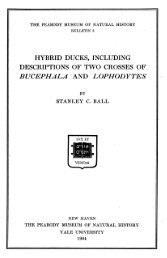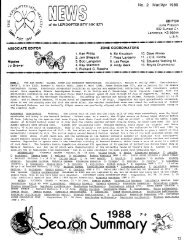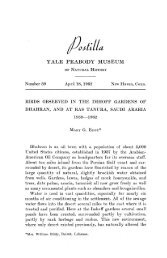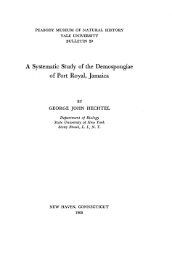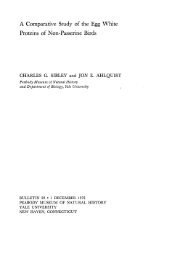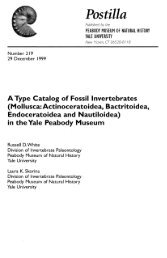Download the report here - Peabody Museum of Natural History ...
Download the report here - Peabody Museum of Natural History ...
Download the report here - Peabody Museum of Natural History ...
Create successful ePaper yourself
Turn your PDF publications into a flip-book with our unique Google optimized e-Paper software.
Engaging Our<br />
Communities
“so <strong>here</strong> we…<br />
sit in <strong>the</strong>se places <strong>of</strong> knowledge and beauty.<br />
We see barriers that keep people away<br />
- tangible barriers,<br />
like transportation and <strong>the</strong> cost <strong>of</strong> admission<br />
- and intangible barriers,<br />
like feeling unwelcome, intimidated or irrelevant.<br />
We wrestle with how to take <strong>the</strong>se barriers down,<br />
how to get our ‘stuff’ out to communities<br />
who can’t or don’t come in,<br />
how to say to folks in words and actions that<br />
you are wanted and valued <strong>here</strong>.”<br />
– Ellen Wahl, 2003
Foreword<br />
One <strong>of</strong> <strong>the</strong> most pressing problems <strong>of</strong> <strong>the</strong> 21 st century is <strong>the</strong><br />
preservation <strong>of</strong> <strong>the</strong> world’s biological and cultural diversity.<br />
By virtue <strong>of</strong> our tremendous resources as part <strong>of</strong> a<br />
university with a strong commitment to environmental<br />
research, coupled with our own world-class collections,<br />
<strong>the</strong> Yale <strong>Peabody</strong> <strong>Museum</strong> is well positioned to play an<br />
important role in improving scientific literacy in this area.<br />
As modern threats to <strong>the</strong> diversity <strong>of</strong> life and culture<br />
continue to intensify, such literacy is becoming increasingly<br />
important.<br />
However, one <strong>of</strong> <strong>the</strong> most fundamental challenges to<br />
achieving this goal is how to engage museum audiences<br />
that are truly representative <strong>of</strong> <strong>the</strong> community. Creating<br />
stronger partnerships is essential to attracting and involving<br />
communities that do not have a museum-going tradition, and<br />
to building ownership in an institution that may seem<br />
unwelcoming. This is true for many museums. A university<br />
museum must also address <strong>the</strong> perception that it is part <strong>of</strong><br />
an elitist institution that has no interest in its surrounding<br />
neighborhoods. As a university institution at <strong>the</strong> heart <strong>of</strong> a<br />
diverse city, overcoming <strong>the</strong>se challenges is <strong>of</strong> overriding<br />
importance to <strong>the</strong> <strong>Peabody</strong> <strong>Museum</strong>.<br />
While we have been successful in our efforts to build<br />
such relationships, and have already worked with several<br />
community partners, we still have a long way to go.<br />
Engaging Our Communities set out to look at <strong>the</strong><br />
obstacles to this process, examining what our audiences<br />
and potential audiences have to say about us, and how we<br />
can better meet <strong>the</strong>ir needs. Our goals are to transform<br />
community representatives into partners in <strong>the</strong> life <strong>of</strong> <strong>the</strong><br />
<strong>Museum</strong>, and to position <strong>the</strong> <strong>Museum</strong>’s programs to meet<br />
<strong>the</strong> most crucial local needs, with science education<br />
foremost among <strong>the</strong>m.<br />
The <strong>Museum</strong> has been very fortunate to have been able<br />
to work with <strong>the</strong> renowned evaluation firm Randi Korn<br />
& Associates. This <strong>report</strong>, largely based on <strong>the</strong>ir work,<br />
.<br />
3<br />
focuses on <strong>the</strong> results and conclusions <strong>of</strong> most interest to<br />
o<strong>the</strong>r cultural institutions, particularly those in a university<br />
setting. I hope that it will be useful to o<strong>the</strong>r institutions<br />
facing <strong>the</strong> challenges that confront <strong>the</strong> <strong>Peabody</strong>.<br />
This project would not have been possible without <strong>the</strong><br />
assistance <strong>of</strong> <strong>the</strong> Jessie Ball duPont Fund, and I am<br />
extremely grateful for <strong>the</strong>ir support. By enabling us to<br />
converse widely with our audience and begin building<br />
deeper relationships, <strong>the</strong> Engaging Our Communities<br />
project will help us more clearly identify <strong>the</strong> needs <strong>of</strong><br />
our community and create new partnerships as we<br />
plan for <strong>the</strong> future.<br />
Michael J. Donoghue<br />
Director &<br />
G. Evelyn Hutchinson Pr<strong>of</strong>essor <strong>of</strong> Ecology &<br />
Evolutionary Biology<br />
February 2005
Table <strong>of</strong> Contents<br />
Introduction 5<br />
The Yale <strong>Peabody</strong> <strong>Museum</strong> 7<br />
Project Background 9<br />
Research Objectives and Methodology 10<br />
Key Findings 11<br />
Conclusions and Recommendations 17<br />
References 21<br />
.<br />
4
Introduction<br />
.<br />
5 .<br />
One <strong>of</strong> <strong>the</strong> most challenging problems for museums as we<br />
enter <strong>the</strong> 21 st century is how to attract a more diverse<br />
audience that is more truly representative <strong>of</strong> our<br />
communities. All people are potential museum visitors,<br />
but <strong>the</strong> probability <strong>of</strong> visiting a museum ei<strong>the</strong>r on a school<br />
fieldtrip or as a leisure-time activity varies greatly among<br />
different groups. Significant variables that account for<br />
under-utilization <strong>of</strong> museums by certain segments <strong>of</strong> <strong>the</strong><br />
population include socio-economic factors (e.g., education,<br />
income), institutional factors (e.g., real or perceived<br />
institutional bias); and cultural factors (Falk 1993; Hood<br />
1993; Smithsonian Institution 2001). The effect <strong>of</strong> <strong>the</strong>se<br />
factors varies for different institutions and different<br />
communities, but all studies have shown that <strong>the</strong> single<br />
most powerful predictor <strong>of</strong> museum-going behavior is<br />
education (Pommerehne and Frey 1980; Hood 1994).<br />
Many museums have attempted to diversify <strong>the</strong>ir general<br />
audiences. Common techniques include: adapting existing<br />
<strong>of</strong>ferings, such as exhibition and public programs;<br />
modifying <strong>the</strong> setting in which audiences experience<br />
programs; and promoting activities more effectively to<br />
underrepresented communities (Smithsonian Institution<br />
2001). While <strong>the</strong>se activities <strong>of</strong>ten have a temporary<br />
impact and <strong>the</strong> museum sees a shift in its audience<br />
composition, <strong>the</strong> new visitors rarely become permanent<br />
members <strong>of</strong> general museum audiences (Smithsonian<br />
Institution 2002). Without follow-through <strong>the</strong> museum loses<br />
its newly acquired audience. As Eric Jolly (2002) comments,<br />
“sustainable diversity entails mutuality between <strong>the</strong> science<br />
center’s decision makers and community leaders; ongoing<br />
relations with current and potential audience members….<br />
Sustainable diversity is not: relying solely on outreach work<br />
with underserved audiences; <strong>of</strong>fering a heritage month<br />
event once a year….” To build an ongoing relationship<br />
with nontraditional audiences, a museum needs to<br />
permanently modify its <strong>of</strong>ferings to meet <strong>the</strong> needs <strong>of</strong><br />
<strong>the</strong>se groups and create a feeling <strong>of</strong> membership<br />
(Smithsonian Institution 2002).<br />
Research has shown that <strong>the</strong>re are several significant factors<br />
that encourage nontraditional audiences to use museums.<br />
Perhaps <strong>the</strong> most important is that people want to feel<br />
welcomed (Falk 1993; Randi Korn & Associates 1997;<br />
Lessane 2003). Communities also need to feel that <strong>the</strong>y<br />
have a real relationship to <strong>the</strong> institution and that <strong>the</strong><br />
programs are relevant to <strong>the</strong>m (Hood 1994; Smithsonian<br />
Institution 2002). Communication is particularly important:<br />
grassroots marketing and visibility in <strong>the</strong> neighborhoods<br />
encourages people to think <strong>the</strong> museum really cares about<br />
whe<strong>the</strong>r <strong>the</strong>y come (Wallace Foundation 1998).<br />
Changing people’s perception <strong>of</strong> museums and building<br />
relationships to encourage broader involvement is a slow<br />
process and requires significant resources over time<br />
(Wagner and o<strong>the</strong>rs 2000; Jolly 2002). An example is <strong>the</strong>
M DOLITTLE<br />
PISEC project in Philadelphia which has spent <strong>the</strong> last<br />
12 years developing relationships with community<br />
organizations (Wagner and o<strong>the</strong>rs 2000). The first step<br />
in building <strong>the</strong>se relationships is to discover what <strong>the</strong><br />
perceptions are for a particular institution and<br />
collaboratively look at ways to overcome <strong>the</strong> barriers<br />
that are preventing people from using <strong>the</strong> museum. The<br />
purpose <strong>of</strong> <strong>the</strong> Engaging Our Communities project was to<br />
take this step with one <strong>of</strong> <strong>the</strong> <strong>Peabody</strong>’s most important<br />
audiences – <strong>the</strong> New Haven community.<br />
M DOLITTLE<br />
. 6
The Yale <strong>Peabody</strong> <strong>Museum</strong><br />
.<br />
7 .<br />
The mission <strong>of</strong> <strong>the</strong> Yale <strong>Peabody</strong> <strong>Museum</strong> is to increase<br />
understanding <strong>of</strong> <strong>the</strong> earth’s history through geological, biological<br />
and anthropological research, and to communicate<br />
<strong>the</strong> results <strong>of</strong> this research to <strong>the</strong> widest possible audience<br />
through publication, exhibition and educational programs.<br />
Such understanding and communication is increasingly<br />
important as modern threats to <strong>the</strong> diversity <strong>of</strong> life and<br />
culture continue to intensify.<br />
The Yale <strong>Peabody</strong> <strong>Museum</strong> was founded in 1866 when<br />
George <strong>Peabody</strong> made a substantial donation for <strong>the</strong><br />
construction <strong>of</strong> a museum to house Yale’s growing collections<br />
<strong>of</strong> natural and cultural history. That same year <strong>Peabody</strong>’s<br />
nephew Othniel Charles Marsh was appointed Pr<strong>of</strong>essor <strong>of</strong><br />
Paleontology at Yale, <strong>the</strong> first such pr<strong>of</strong>essorship in <strong>the</strong><br />
United States. With his inheritance from his uncle, Marsh<br />
amassed large collections <strong>of</strong> vertebrate and invertebrate<br />
fossils, and archaeological and ethnographical objects.<br />
Between 1870 and 1873 Marsh led expeditions into <strong>the</strong> wild<br />
American West in search <strong>of</strong> fossils, <strong>the</strong> most famous <strong>of</strong> which<br />
are dinosaurs he named, including Apatosaurus,<br />
Stegosaurus and Triceratops.<br />
By <strong>the</strong> end <strong>of</strong> <strong>the</strong> 19 th century, <strong>the</strong> <strong>Museum</strong>’s vision had<br />
broadened to include all aspects <strong>of</strong> both cultural and<br />
natural history. To fulfill <strong>the</strong> enlarged mission, specimens<br />
and artifacts were acquired that laid <strong>the</strong> foundation for <strong>the</strong><br />
<strong>Museum</strong>’s large and early collections in North American<br />
and world ethnography, archaeology and biological sciences.<br />
The present <strong>Peabody</strong> building was opened in 1925 to house<br />
<strong>the</strong> rapidly growing collections, which now total over<br />
11 million specimens and objects. One <strong>of</strong> <strong>the</strong> largest natural<br />
history collections in North America, <strong>the</strong>y <strong>of</strong>fer crucial<br />
keys to <strong>the</strong> understanding <strong>of</strong> <strong>the</strong> diversity and history <strong>of</strong><br />
life and culture.<br />
The <strong>Museum</strong>’s public programs principally serve local and<br />
regional communities. In addition to Marsh’s dinosaurs<br />
and mammals, <strong>the</strong> exhibitions include <strong>the</strong> famous The Age<br />
<strong>of</strong> Reptiles mural, one <strong>of</strong> <strong>the</strong> world’s largest and most wellknown<br />
paintings <strong>of</strong> dinosaurs; spectacular dioramas <strong>of</strong><br />
North American and Connecticut wildlife; and an active<br />
temporary exhibition program. The <strong>Museum</strong> welcomes<br />
approximately 160,000 visitors a year.
In 1925 <strong>the</strong> <strong>Museum</strong> formed a School Service program,<br />
reputedly <strong>the</strong> first in a university natural history museum.<br />
Today this <strong>of</strong>fice oversees visits by 35,000 school children<br />
each year, organizes teacher pr<strong>of</strong>essional development<br />
opportunities, and staffs <strong>the</strong> <strong>Museum</strong>’s interactive, hands-on<br />
Discovery Room. In 1996 <strong>the</strong> <strong>Museum</strong> established an Events<br />
Office to organize special weekend and holiday programs,<br />
and now presents 10 major events annually as well as many<br />
lectures and children’s activities.<br />
.<br />
8
Project Background<br />
The “<strong>Peabody</strong>” is part <strong>of</strong> <strong>the</strong> landscape <strong>of</strong> New Haven. It<br />
has won <strong>the</strong> New Haven Advocate citywide readers poll for<br />
“Best <strong>Museum</strong>/Art Gallery” for nine years in a row. Every<br />
taxi driver knows w<strong>here</strong> it is and every local school student<br />
has visited. Its reputation as a “dinosaur” museum draws an<br />
audience typical <strong>of</strong> many natural history museums; largely<br />
adults with young children and school groups Grades K - 4.<br />
The Greater New Haven community is economically and<br />
racially diverse. The majority <strong>of</strong> New Haven residents<br />
(54%) are people <strong>of</strong> color and <strong>the</strong> poverty rate is three times<br />
<strong>the</strong> state average (New Haven Census 2000). In <strong>the</strong> last few<br />
years <strong>the</strong> <strong>Museum</strong> has developed specific programs to<br />
engage this audience. Our major event, inaugurated in 1997,<br />
is <strong>the</strong> annual Dr. Martin Lu<strong>the</strong>r King, Jr.’s Legacy <strong>of</strong><br />
Environmental and Social Justice family festival. Working<br />
toge<strong>the</strong>r with a group <strong>of</strong> over 40 community, business,<br />
political and church leaders, <strong>the</strong> <strong>Museum</strong> has grown this<br />
event each year. This year several thousand visitors<br />
attended <strong>the</strong> festival, making it one <strong>of</strong> <strong>the</strong> largest such<br />
celebrations in Connecticut. The success <strong>of</strong> this event led to<br />
a collaboration with <strong>the</strong> nonpr<strong>of</strong>it social services agency,<br />
Junta for Progressive Action Inc., which serves <strong>the</strong> city’s<br />
Latino population, on Fiesta Latina!, a similar multicultural<br />
celebration inaugurated in 2003.<br />
Despite <strong>the</strong>se and o<strong>the</strong>r efforts, <strong>the</strong> <strong>Museum</strong> has a long way<br />
to go in establishing long-term relationships with <strong>the</strong> city’s<br />
diverse community, particularly people <strong>of</strong> color. Key<br />
questions we had were:<br />
• Who visits <strong>the</strong> <strong>Museum</strong> and does this audience differ<br />
for our cultural events?<br />
• What is <strong>the</strong> perception nonmuseum goers have <strong>of</strong> <strong>the</strong><br />
<strong>Museum</strong> and what are <strong>the</strong> barriers to <strong>the</strong>ir engagement<br />
with <strong>the</strong> <strong>Museum</strong>?<br />
• How can we attract visitors from our local community<br />
and encourage repeat visits?<br />
• How does being part <strong>of</strong> Yale University affect people’s<br />
relationship with <strong>the</strong> <strong>Museum</strong>?<br />
.<br />
9<br />
To help answer <strong>the</strong>se questions <strong>the</strong> <strong>Museum</strong> undertook this<br />
in-depth evaluation project focused on <strong>the</strong> New Haven<br />
community. It had two components. Randi Korn &<br />
Associates organized visitor questionnaires and focus<br />
groups in <strong>the</strong> community. The Project Coordinator and<br />
o<strong>the</strong>r staff conducted a series <strong>of</strong> interviews around New<br />
Haven during <strong>the</strong> summer and fall <strong>of</strong> 2004.
Research Objectives &<br />
Methodology<br />
.<br />
1 .<br />
The specific objectives <strong>of</strong> <strong>the</strong> project’s audience research<br />
were to:<br />
• Understand <strong>the</strong> demographic and psychographic<br />
characteristics <strong>of</strong> <strong>Museum</strong> visitors who attend<br />
special programs.<br />
• Understand New Haven community residents’<br />
perceptions and attitudes about <strong>the</strong> <strong>Museum</strong>.<br />
• Determine New Haven community residents’<br />
emotional and cognitive barriers to visiting <strong>the</strong><br />
<strong>Museum</strong> regularly.<br />
• Determine New Haven community residents’<br />
leisure habits.<br />
• Determine New Haven community residents’<br />
ideal museum experiences.<br />
Since we wanted to talk with visitors and nonvisitors, <strong>the</strong><br />
research was organized into two parts. Using a standardized<br />
questionnaire specially trained staff and volunteers conducted<br />
face-to-face interviews with adult visitors at three winter<br />
2004 programs. Two <strong>of</strong> those programs, Dr. Martin Lu<strong>the</strong>r<br />
King, Jr.’s Legacy <strong>of</strong> Environmental and Social Justice and<br />
Fiesta Latina!, are targeted at specific audiences, while <strong>the</strong><br />
third, Dinosaur Days, draws a general audience during <strong>the</strong><br />
February school vacation. A total <strong>of</strong> 790 questionnaires<br />
were completed. To reach nonvisitors, focus groups were<br />
held at <strong>the</strong> Stetson Library, located near <strong>the</strong> <strong>Museum</strong> in an<br />
underserved New Haven neighborhood. A pr<strong>of</strong>essional focus<br />
group facility recruited and selected New Haven residents<br />
who had never visited <strong>the</strong> <strong>Museum</strong>, or had not visited for a<br />
very long time. Four focus groups were scheduled, each with<br />
10 participants, in April 2004.<br />
In addition to formal evaluation, <strong>the</strong> Project<br />
Coordinator, sometimes accompanied by o<strong>the</strong>r<br />
staff, met with over 25 community leaders to<br />
discuss key questions about <strong>the</strong> <strong>Museum</strong>’s<br />
public activities and its future. While <strong>the</strong><br />
conversations were informal and <strong>of</strong>ten<br />
covered a wide variety <strong>of</strong> topics, <strong>the</strong> primary<br />
questions focused on leisure habits, museum<br />
visiting behavior, perceptions <strong>of</strong> <strong>the</strong><br />
<strong>Peabody</strong>, and suggestions for ways in which<br />
<strong>the</strong> <strong>Peabody</strong> could better partner with<br />
<strong>the</strong>m. Participants included local clergy,<br />
community leaders, aldermen, and<br />
representatives <strong>of</strong> local nonpr<strong>of</strong>it<br />
organizations.
Key Findings<br />
.<br />
11.<br />
8%<br />
28%<br />
MLK Days: Attendance by Ethnicity<br />
11%<br />
28%<br />
4% 1%<br />
Fiesta Latina!: Attendance by Ethnicity<br />
16%<br />
1%<br />
1%<br />
4%<br />
Caucasian/White African American/Black Hispanic/Latino<br />
O<strong>the</strong>r/Multiple Asian American Indian<br />
48%<br />
16%<br />
8%<br />
51%<br />
Dinosaur Days: Attendance by Ethnicity<br />
4%<br />
<strong>Museum</strong> Visitors<br />
Demographics:<br />
3% 2%<br />
• The <strong>Museum</strong>’s audience is largely local: 48% <strong>of</strong> our<br />
visitors come from within <strong>the</strong> Greater New Haven<br />
area and 42% from elsew<strong>here</strong> in Connecticut.<br />
• 75% <strong>of</strong> visitors came with children.<br />
• 55% are college graduates.<br />
• The <strong>Museum</strong> draws a culturally diverse audience,<br />
particularly for special events. Overall, 58% <strong>of</strong> visitors<br />
identified <strong>the</strong>mselves as Caucasian/White, 19% as<br />
African American/Black, and 13% as Hispanic/Latino.<br />
T<strong>here</strong> were significant differences among <strong>the</strong> events.<br />
19%<br />
13%<br />
67%<br />
Overall Attendance by Ethnicity<br />
6%<br />
3% 1%<br />
58%
Visit characteristics:<br />
• 65% <strong>of</strong> respondents were repeat visitors. The disparity<br />
between events was considerable – nearly 75% <strong>of</strong><br />
visitors to <strong>the</strong> Martin Lu<strong>the</strong>r King, Jr. Day festival were<br />
repeat visitors while only 56% <strong>of</strong> visitors to Dinosaur<br />
Days were repeat visitors.<br />
•Visitors were given <strong>the</strong> opportunity to select a number<br />
<strong>of</strong> responses as to why <strong>the</strong>y had come to <strong>the</strong> <strong>Museum</strong><br />
that day. Overall, 49% came to see <strong>the</strong> <strong>Museum</strong> or a<br />
special exhibition and 46% came to attend <strong>the</strong> specific<br />
event that day. The charts below show some significant<br />
differences between event days: 71% <strong>of</strong> visitors on<br />
MLK Day had come to attend <strong>the</strong> event, while only<br />
29% <strong>of</strong> visitors on Dinosaur Days had done so.<br />
Generally, visitor perceptions <strong>of</strong> <strong>the</strong> <strong>Museum</strong> were very<br />
positive, with high ratings for being a “great place for<br />
families,” “welcoming” and having “a variety <strong>of</strong> interesting<br />
things to do.” Their overall experience was also positive, with<br />
a rating <strong>of</strong> 6.08 (on a 7-point scale). The significant variables<br />
associated with this score were age and visiting with children.<br />
Older people and people visiting with children gave <strong>the</strong><br />
<strong>Museum</strong> a higher rating. Over 80% <strong>of</strong> respondents had<br />
interacted with <strong>the</strong> frontline staff, and found <strong>the</strong>m very<br />
knowledgeable and helpful. Suggestions for improvements<br />
in <strong>the</strong> visitor experience focused on amenities, notably food<br />
services (<strong>the</strong> <strong>Museum</strong> does not provide any), parking<br />
and restrooms.<br />
. 12<br />
80<br />
70<br />
60<br />
50<br />
40<br />
30<br />
20<br />
10<br />
0<br />
7<br />
6<br />
5<br />
4<br />
3<br />
2<br />
1<br />
0<br />
Reason for Visiting<br />
MLK Days Fiesta Latina Dinosaur Days Overall<br />
“A great place<br />
for adults”<br />
See <strong>Museum</strong><br />
Attend Event<br />
Educational reason<br />
Social reason<br />
Perceptions <strong>of</strong> <strong>the</strong> <strong>Museum</strong> (Scale 1 - 7)<br />
“A great place<br />
for children”<br />
“Welcoming” “A variety <strong>of</strong> “Place w<strong>here</strong><br />
things to do” exhibits change<br />
regularly”
.<br />
13.<br />
<strong>Museum</strong> Nonvisitors<br />
The focus group study was conducted with New Haven<br />
residents who had never visited <strong>the</strong> <strong>Peabody</strong>, or who had<br />
not done so for a long time. Focus groups are a qualitative<br />
research tool that provide a rich source <strong>of</strong> in-depth information<br />
on <strong>the</strong> perceptions and experiences <strong>of</strong> <strong>the</strong> <strong>Museum</strong>, as<br />
well as eliciting suggestions for <strong>the</strong> future. In general <strong>the</strong><br />
results were almost <strong>the</strong> exact opposite <strong>of</strong> <strong>the</strong> data seen in<br />
<strong>the</strong> visitor evaluation.<br />
Background information:<br />
• 68% <strong>of</strong> <strong>the</strong> focus group participants were African<br />
American/Black, and 24% were Hispanic/Latino.<br />
• 78% had completed less than four years <strong>of</strong> college.<br />
• 51% had children in <strong>the</strong>ir households.<br />
• 42% never visited museums and ano<strong>the</strong>r 40% visited<br />
museums infrequently.<br />
• When participants did visit museums it was for a<br />
special event or occasion, or while on vacation.<br />
Many <strong>of</strong> <strong>the</strong> participants who said that <strong>the</strong>y do not usually<br />
visit museums preferred to spend <strong>the</strong>ir leisure time on<br />
entertainment-based activities. Several noted that time<br />
pressures cause <strong>the</strong>m to carefully select family activities:<br />
“I wanted to say [one thing] about ano<strong>the</strong>r reason why<br />
you don’t see a lot <strong>of</strong> African-Americans or Hispanics at<br />
museums – it’s because a lot <strong>of</strong> parents don’t have <strong>the</strong><br />
time. You don’t have that extra time to go to a museum.<br />
You barely have <strong>the</strong> time to probably cook dinner and<br />
get <strong>the</strong>m ready for school <strong>the</strong> next day….*I remember<br />
doing a lot <strong>of</strong> sacrificing just so [my daughter] would be<br />
well rounded. But I had to know that my daughter was<br />
going to enjoy <strong>the</strong> place I was taking her and that she’d<br />
get a lot out <strong>of</strong> it. I had to know in advance that it was<br />
worth our time.”<br />
A few participants also saw <strong>the</strong> museum environment as<br />
intimidating or uncomfortable:<br />
“Maybe you haven’t been to a museum before so you<br />
don’t [have] <strong>the</strong> right manners. Since <strong>the</strong>re are no<br />
guided tours or anything you are left [asking]. ‘What<br />
do I do? I don’t know how to act, w<strong>here</strong> do I go next?<br />
Is <strong>the</strong>re anybody to show me?’ ”<br />
When <strong>the</strong> discussion moved onto <strong>the</strong> <strong>Peabody</strong> <strong>Museum</strong>, it<br />
became apparent that nearly all <strong>the</strong> participants (85%) had<br />
visited <strong>the</strong> <strong>Museum</strong>, but most had not visited for a long time.<br />
This is typical <strong>of</strong> many New Haven residents as all New<br />
Haven school children visit <strong>the</strong> <strong>Museum</strong> at least once. Most<br />
<strong>of</strong>fered negative opinions about <strong>the</strong> <strong>Museum</strong>, which<br />
corresponded to five common perceptions:<br />
No connection with <strong>the</strong> community. Most participants<br />
expressed negative feelings about Yale University and <strong>the</strong><br />
<strong>Peabody</strong> <strong>Museum</strong> and were skeptical about whe<strong>the</strong>r <strong>the</strong><br />
<strong>Museum</strong> was really committed to being part <strong>of</strong> <strong>the</strong> community.<br />
“Yale needs to get up and come out <strong>here</strong>. Start knocking<br />
on doors, meeting <strong>the</strong> neighbors and shaking hands….<br />
They need to say ‘Hey let’s share this stuff – come to<br />
<strong>the</strong> <strong>Museum</strong>’.”<br />
“All my children are grown now, [but] when <strong>the</strong>y were<br />
young we used to go to <strong>the</strong> <strong>Peabody</strong> <strong>Museum</strong>.… They<br />
went because… <strong>of</strong> something to do with school. The
teacher gave <strong>the</strong>m a flyer that said <strong>the</strong>re’s a new exhibit<br />
at <strong>the</strong> <strong>Peabody</strong> <strong>Museum</strong>. But after that was over <strong>the</strong>re<br />
wasn’t a consistent... connection to <strong>the</strong> <strong>Museum</strong>…. The<br />
<strong>Museum</strong> is sitting <strong>the</strong>re, but it’s set aside somewhat from<br />
<strong>the</strong> community.”<br />
The content does not connect with <strong>the</strong> community.<br />
Most participants perceived <strong>the</strong> <strong>Museum</strong> as displaying only<br />
dinosaur bones and taxidermied animals and said <strong>the</strong>y were<br />
not interested in <strong>the</strong> <strong>Museum</strong>’s exhibits because <strong>the</strong>y did not<br />
connect with <strong>the</strong>m personally.<br />
“As a Hispanic, my kids have grown up <strong>here</strong>, <strong>the</strong>y were<br />
born <strong>here</strong>, and <strong>the</strong>y’re very americanized, but I do want<br />
<strong>the</strong>m to grow up knowing more about South America.<br />
They wouldn’t have to do away with what <strong>the</strong>y have –<br />
<strong>the</strong> dinosaurs. They just need to include people – something<br />
alive. *Right. Like say this fossil came from South<br />
America, so you make some sort <strong>of</strong> correlation between<br />
<strong>the</strong> two places – between people and <strong>the</strong> bones.”<br />
“Those big bones [have] absolutely<br />
nothing to do with me, because my people<br />
didn’t find it, you need to show me<br />
how that bone connects with me. Why<br />
is it <strong>here</strong>? Why is it important?”<br />
.<br />
14<br />
Inadequate communication with <strong>the</strong> community.<br />
Some participants had seen <strong>the</strong> <strong>Museum</strong>’s local advertising<br />
and knew <strong>of</strong> its cultural events. Many had not, and most<br />
thought <strong>the</strong> <strong>Museum</strong> needed to make much more <strong>of</strong> an<br />
ongoing effort to increase awareness <strong>of</strong> <strong>the</strong> <strong>Museum</strong> and to<br />
foster an ongoing relationship with <strong>the</strong> community.<br />
“I feel like one <strong>of</strong> <strong>the</strong> reasons that African Americans<br />
don’t go to museums [is] because a lot <strong>of</strong> us haven’t been<br />
exposed to it…. If I hadn’t gone with my school, I don’t<br />
think I would have [gone to a museum]. My parents, I<br />
don’t think <strong>the</strong>y’ve been to a museum ei<strong>the</strong>r…. I think<br />
you need to advertise <strong>the</strong> <strong>Museum</strong>…. *Every couple<br />
<strong>of</strong> months send out a flyer… regardless <strong>of</strong> whe<strong>the</strong>r<br />
it’s African drumming or whatever. Start inviting<br />
<strong>the</strong>m to all <strong>the</strong> events…. Then people will not<br />
feel [like] you just wanted <strong>the</strong>m <strong>the</strong>re for<br />
Martin Lu<strong>the</strong>r King Day and that’s it.”
.<br />
15 .<br />
The target audience is unclear. Participants were not<br />
sure whe<strong>the</strong>r it was a museum for children or not. While <strong>the</strong><br />
<strong>Museum</strong>’s focus on dinosaurs suggested it was for families, it<br />
was felt <strong>the</strong> lack <strong>of</strong> interactive exhibits indicated it was not.<br />
“I’m not sure <strong>the</strong> <strong>Peabody</strong> is really a place for kids….<br />
The kids nowadays … need hands-on interactive stuff.<br />
Things that kids can touch and feel and play games.<br />
They don’t want to go <strong>the</strong>re and just look.”<br />
The experiences <strong>of</strong>fered are uninteresting and static.<br />
When asked about <strong>the</strong>ir past visits to <strong>the</strong> <strong>Museum</strong> many<br />
recalled having negative experiences. Most <strong>of</strong>ten this was<br />
<strong>the</strong> recollection <strong>of</strong> a childhood visit. They stated that <strong>the</strong><br />
<strong>Museum</strong> had been “boring,” felt very inhospitable, and<br />
lacked interactive exhibits.<br />
“I know <strong>the</strong>y’re not going to get rid <strong>of</strong> that big fossil…<br />
but if <strong>the</strong>y could liven it up with lights or something….<br />
*They should put on fireworks in <strong>the</strong> parking lot near<br />
<strong>the</strong> <strong>Museum</strong> – do some fun stuff for <strong>the</strong> community.”<br />
Community Interviews<br />
Generally <strong>the</strong> conversations with community leaders<br />
mirrored those in <strong>the</strong> focus groups. Individuals associated<br />
with nonpr<strong>of</strong>it organizations were more likely to have a<br />
positive perception <strong>of</strong> <strong>the</strong> <strong>Museum</strong> as a place w<strong>here</strong> <strong>the</strong>y and<br />
<strong>the</strong>ir family had an enjoyable experience. Usually those<br />
individuals were frequent museum goers.<br />
“I remember seeing all <strong>the</strong> dinosaurs and how beautiful<br />
<strong>the</strong>y were put toge<strong>the</strong>r. They looked real and <strong>the</strong><br />
awesomeness <strong>of</strong> <strong>the</strong>ir details stayed with me. I can still<br />
remember <strong>the</strong>m to this day.”<br />
However, many <strong>of</strong> <strong>the</strong> interviewees mentioned that <strong>the</strong>y and<br />
<strong>the</strong>ir communities had felt unwelcome when visiting <strong>the</strong><br />
<strong>Museum</strong> in <strong>the</strong> past, and that feeling welcome was a very<br />
important part <strong>of</strong> deciding how to spend <strong>the</strong>ir limited leisure<br />
time:<br />
“Well first and foremost it has to be a place that I would<br />
feel comfortable taking even <strong>the</strong> youngest <strong>of</strong> my<br />
grandchildren.”<br />
Most people knew <strong>the</strong> <strong>Museum</strong> as a “dinosaur” museum.<br />
However, as in <strong>the</strong> focus groups, several people felt that <strong>the</strong><br />
<strong>Museum</strong> was not attractive to younger children because <strong>of</strong><br />
<strong>the</strong> lack <strong>of</strong> interactive exhibits and technical nature <strong>of</strong> <strong>the</strong><br />
exhibit interpretation.<br />
“I mean I know it’s a <strong>Museum</strong> that children can’t<br />
touch… but when you are taking children that is not a<br />
good thing – <strong>the</strong>y have to be welcomed. I know <strong>the</strong> most<br />
wonderful thing that <strong>the</strong>y have added <strong>the</strong>re is <strong>the</strong><br />
Discovery Room, w<strong>here</strong> <strong>the</strong>y can actually go in and<br />
touch things.”<br />
“You have to be very mature to understand <strong>the</strong> <strong>Peabody</strong>,<br />
you have to have background history to have any idea<br />
what <strong>the</strong> exhibits are about.”<br />
Interestingly only one individual brought up <strong>the</strong> <strong>Museum</strong>’s<br />
focus on evolution, which had been considered by <strong>the</strong><br />
<strong>Museum</strong> to be a possible obstacle for certain communities.<br />
Several mentioned that since children visited with <strong>the</strong>ir
schools many parents felt <strong>the</strong>re was no need to take <strong>the</strong>m<br />
to <strong>the</strong> <strong>Peabody</strong> again.<br />
Interviewees emphasized that attracting <strong>the</strong> local community<br />
would require a sustained effort to build partnerships, and<br />
that while <strong>the</strong> MLK Day and Fiesta Latina! events were a<br />
good start, such events should not be limited to one day a<br />
year but become a regular part <strong>of</strong> <strong>the</strong> <strong>Museum</strong>’s calendar.<br />
They cautioned that it was important that <strong>the</strong> <strong>Museum</strong><br />
consistently and continually welcomed <strong>the</strong> community.<br />
Many mentioned <strong>the</strong> importance <strong>of</strong> regular marketing within<br />
<strong>the</strong> neighborhoods. T<strong>here</strong> were several discussions about<br />
admission prices being a deterrent, and interviewees felt<br />
that discount programs were important.<br />
.<br />
16<br />
Encouragingly, most organizations were very positive about<br />
working with <strong>the</strong> <strong>Peabody</strong>. Suggestions for <strong>the</strong> future<br />
included having staff go out into <strong>the</strong> community to deliver<br />
programs and encourage people to visit; programs for<br />
seniors; summer programs for inner-city youth; after-school<br />
programs; more frequent cultural events; and diversity<br />
training for staff.
Conclusions &<br />
Recommendations<br />
. .<br />
17<br />
The <strong>Museum</strong> is serving its existing visitors well. People gave<br />
high ratings in nearly all questionnaire categories. The<br />
suggested areas <strong>of</strong> improvement were related to visitor<br />
amenities, which we recognize as a problem. The visitor<br />
demographics, particularly <strong>the</strong> diversity <strong>of</strong> <strong>the</strong> audience,<br />
were very encouraging. Eighteen years ago <strong>the</strong> <strong>Museum</strong><br />
carried out a visitor survey that showed 94% <strong>of</strong> our visitors<br />
were Caucasian/White, 3% were African American/Black,<br />
and 2% were Hispanic/Latino. Four years ago 89% <strong>of</strong> our<br />
visitors were Caucasian/White. However information<br />
ga<strong>the</strong>red during Dinosaur Days (<strong>the</strong> only event studied<br />
which was not specifically cultural) showed 67% <strong>of</strong> visitors<br />
were Caucasian/White, 16% were African American/Black,<br />
and 8% were Hispanic/Latino. This steady improvement is<br />
likely <strong>the</strong> result <strong>of</strong> many factors, but undoubtedly <strong>the</strong><br />
increasingly active events program has played a part.<br />
The results <strong>of</strong> this study are similar to those from o<strong>the</strong>r<br />
museums in urban settings (see Randi Korn & Associates<br />
1997; Johnson & Green 1997). T<strong>here</strong> is an obvious contrast<br />
between <strong>Peabody</strong> visitors and nonvisitors in terms <strong>of</strong> education,<br />
ethnicity and museum-going behavior. Also, focus<br />
group participants’ attitudes and perceptions were almost<br />
completely <strong>the</strong> opposite <strong>of</strong> those expressed in <strong>the</strong> visitor<br />
questionnaires. While <strong>the</strong> <strong>Museum</strong>’s cultural programs are<br />
diversifying our audience and providing a good experience<br />
for visitors, those who attend are <strong>of</strong>ten frequent museum<br />
goers. This suggests that <strong>the</strong> <strong>Museum</strong> will need to make<br />
significant changes if it hopes to attract and satisfy<br />
nonvisitors – changes in how <strong>the</strong> <strong>Museum</strong> communicates<br />
and partners with <strong>the</strong> community, and changes in how<br />
programs and services are delivered.<br />
The differences between <strong>the</strong> focus<br />
groups and museum visitors seem to be<br />
primarily attributable to three reasons:<br />
museum visiting patterns, past experiences<br />
at <strong>the</strong> <strong>Peabody</strong>, and attitudes<br />
towards Yale itself.
• <strong>Museum</strong> visiting patterns. Questionnaire respondents<br />
tend to visit museums, which suggests <strong>the</strong>y are comfortable<br />
in traditional museum environments. Focus group<br />
participants have much less experience visiting<br />
museums and as such have different expectations for<br />
<strong>the</strong>ir free time. The <strong>Museum</strong> needs to provide<br />
nontraditional interpretation that helps nonvisitors<br />
to see <strong>the</strong> significance and relevance <strong>of</strong> exhibits. For<br />
example, many participants emphasized <strong>the</strong> importance<br />
<strong>of</strong> entertainment, multi-sensory experiences<br />
(such as music and food), and social experiences.<br />
Such experiences are already a feature <strong>of</strong> some <strong>of</strong><br />
<strong>the</strong> <strong>Museum</strong>’s special events.<br />
• Past <strong>Peabody</strong> <strong>Museum</strong> experiences. Most focus group<br />
participants had not attended <strong>the</strong> <strong>Museum</strong> for a long<br />
time. In <strong>the</strong>ir recollections <strong>the</strong>y mentioned feeling<br />
intimidated and having had negative experiences with<br />
frontline staff. These memories had colored <strong>the</strong>ir perception<br />
<strong>of</strong> <strong>the</strong> <strong>Museum</strong> for years. Research has shown<br />
that infrequent museum visitors <strong>of</strong>ten are unclear<br />
about <strong>the</strong> function <strong>of</strong> museum guards and find <strong>the</strong>m<br />
<strong>of</strong>f-putting (Johnson & Green 1997), thus underlining<br />
<strong>the</strong> importance <strong>of</strong> staff training in customer service and<br />
communication skills. Participants also said <strong>the</strong>y had<br />
not enjoyed <strong>the</strong>ir childhood school visit, which<br />
emphasizes <strong>the</strong> importance <strong>of</strong> this opportunity to shape<br />
perceptions. While visiting museums on a school fieldtrip<br />
does not necessarily affect future museumgoing<br />
behavior (Falk 1993; Smithsonian Institution 2001),<br />
it obviously does have an effect on people’s opinions<br />
and attitudes.<br />
• Poor attitudes toward Yale University. Participants<br />
voiced negative opinions about Yale University and its<br />
relationship with <strong>the</strong> surrounding community. Not<br />
surprisingly this adds to <strong>the</strong> perception <strong>of</strong> <strong>the</strong> <strong>Museum</strong><br />
being an elitist institution and acts as a barrier to <strong>the</strong>ir<br />
visiting <strong>the</strong> <strong>Museum</strong>. Participants stressed <strong>the</strong> need for<br />
personal invitations and for <strong>the</strong> <strong>Museum</strong> to come out<br />
into <strong>the</strong> community.<br />
.<br />
18<br />
Understanding <strong>the</strong> community viewpoint is <strong>the</strong> first step in<br />
developing new relationships and is <strong>the</strong> starting point for<br />
change. The <strong>Museum</strong> now needs to devote significant<br />
resources to a thoughtful and consistent effort to provide<br />
mission-oriented experiences <strong>of</strong> relevance to <strong>the</strong> community.<br />
T<strong>here</strong> were several recommendations from <strong>the</strong> evaluators<br />
and participants, including:<br />
• Reach out to <strong>the</strong> community by visiting neighborhoods;<br />
personally invite people to visit <strong>the</strong> <strong>Museum</strong> in <strong>the</strong>ir<br />
churches, community centers and<br />
“places w<strong>here</strong> regular people go.”
.<br />
19.<br />
• Carefully consider our exhibition strategies. Many<br />
people now think <strong>of</strong> museums for children and families<br />
in terms <strong>of</strong> highly interactive institutions. We need to<br />
evaluate our exhibit interpretation in light <strong>of</strong> that<br />
change. We also need to address <strong>the</strong> issue <strong>of</strong> <strong>the</strong><br />
relevance <strong>of</strong> <strong>the</strong> exhibits to <strong>the</strong> community and answer<br />
<strong>the</strong> question “Why is it important to me?” This<br />
includes involving communities more directly in<br />
exhibition planning, focusing on <strong>the</strong> human stories<br />
behind <strong>the</strong> collections and helping visitors understand<br />
<strong>the</strong> significance <strong>of</strong> <strong>the</strong> collections so that <strong>the</strong>y are<br />
proud to have <strong>the</strong> <strong>Peabody</strong> in New Haven.<br />
•Increase <strong>the</strong> interactivity <strong>of</strong> school tours. Many New<br />
Haven residents first visit <strong>the</strong> <strong>Museum</strong> with <strong>the</strong>ir<br />
school and this trip shapes <strong>the</strong>ir perceptions <strong>of</strong> <strong>the</strong><br />
<strong>Museum</strong>, <strong>of</strong>ten for many decades. In addition, many<br />
minority students only come to <strong>the</strong> <strong>Museum</strong> on school<br />
fieldtrips (AAAS 1996). It is <strong>the</strong>refore essential that<br />
such trips provide a positive experience that<br />
encourages students to return.<br />
• Concentrate on family programming. This has <strong>the</strong><br />
greatest potential for success in that <strong>the</strong> programs we<br />
<strong>of</strong>fer seem to work best for families. It has been shown<br />
(Falk 1993; Smithsonian Institution 2001) that children<br />
who attend museums with <strong>the</strong>ir family are much more<br />
likely to visit museums as adults, so over time this will<br />
diversify our audience.<br />
• Craft educational experiences that are entertaining,<br />
social and multi-sensory. Nonvisitors expect and value<br />
different things from <strong>the</strong>ir leisure time than typical<br />
museum visitors. Many <strong>of</strong> our cultural events already<br />
follow this model, but it is important that o<strong>the</strong>r<br />
<strong>Museum</strong> activities follow suit.<br />
• Develop programs to increase <strong>the</strong> number <strong>of</strong> “staff” on<br />
<strong>the</strong> floor at general visitor opening times to encourage<br />
people to enjoy <strong>the</strong>ir visit. Also look at developing tools<br />
to help familiarize people with <strong>the</strong> <strong>Museum</strong>, including<br />
films and tours.<br />
•Provide more training <strong>of</strong> frontline staff in customer<br />
service protocol and dealing with diverse audiences.<br />
• Think more carefully about free admission passes.<br />
Currently <strong>the</strong> <strong>Museum</strong> provides New Haven libraries<br />
with passes for <strong>the</strong>ir patrons, and also gives free passes<br />
to New Haven students when <strong>the</strong>y visit with <strong>the</strong>ir<br />
school. The take-up rate for both <strong>the</strong>se programs is<br />
very low. Suggestions for improving this include giving<br />
passes to churches, aldermen and community organizations<br />
and providing passes for specific event days when<br />
<strong>the</strong>re are many more activities going on.<br />
The <strong>Museum</strong> has already started to move forward on several<br />
<strong>of</strong> <strong>the</strong>se recommendations. For example a new coordinator<br />
has been hired to develop an after school program for students<br />
from three local middle and high schools. These students,<br />
nearly all <strong>of</strong> whom are African American or Hispanic,<br />
come to <strong>the</strong> <strong>Museum</strong> twice a week to learn about behind-<strong>the</strong>scenes<br />
activities and <strong>the</strong> natural and cultural environment.<br />
We hope <strong>the</strong>y, and <strong>the</strong>ir families, will be ambassadors for<br />
<strong>the</strong> <strong>Museum</strong> in <strong>the</strong>ir neighborhoods and also act as<br />
interpreters for exhibitions. We are also entering into a
new partnership with <strong>the</strong> City <strong>of</strong> New Haven’s senior<br />
citizen centers to bring art and botany classes to ano<strong>the</strong>r<br />
population that does not visit <strong>the</strong> <strong>Museum</strong>.<br />
Changing a museum’s relationship to its community is, <strong>of</strong><br />
course, a long-term undertaking that requires considerable<br />
commitment. None <strong>of</strong> <strong>the</strong>se activities, in isolation, will be<br />
effective and all <strong>of</strong> <strong>the</strong>m will require nurturing new<br />
partnerships. As Eric Jolly (2002) observed, museums<br />
need to take as much care and interest in <strong>the</strong>ir community<br />
partners as <strong>the</strong>y do in <strong>the</strong>ir funding partners. For <strong>the</strong><br />
<strong>Peabody</strong> <strong>Museum</strong> Engaging Our Communities is <strong>the</strong> start<br />
<strong>of</strong> this change in thinking.<br />
. 20<br />
M DOOLITTLE
References<br />
AAAS 1996. Project Mosaic: <strong>Museum</strong>s at <strong>the</strong> Crossroads.<br />
Publ American Association for <strong>the</strong> Advancement <strong>of</strong> Science.<br />
70 pp.<br />
Falk, J.H. 1993. Leisure Decisions Influencing African<br />
American Use <strong>of</strong> <strong>Museum</strong>s. Publ. American Association for<br />
<strong>Museum</strong>s. 101 pp.<br />
Hood, M. 1993. After 70 Years <strong>of</strong> Audience Research, What<br />
Have We Learned? Visitor Studies: Theory, Research and<br />
Practice (5): 17-27.<br />
Hood, M. 1994. A View from ‘Outside’ Research on<br />
Community Audiences. Visitor Studies: Theory, Research,<br />
and Practice (7): 77 – 87.<br />
Johnson, K. and Green T. 1997. A New Audience for A New<br />
Century. Publ. Minneapolis Institute <strong>of</strong> Arts. 46pp.<br />
Jolly, E. J. 2002. Confronting Demographic Denial:<br />
Retaining Relevance in <strong>the</strong> New Millenium. In: Eric Jolly on<br />
Sustainable Diversity in Science Centers. ed A. Perez-<br />
Pelaez, J. Walker, & H. Ross. Publ. Association for Science<br />
& Technology Centers. 65pp.<br />
Lessane, P.W. 2003. Making a Way Outta No Way: Lessons<br />
I’ve Learned from Our Diversity Project Community<br />
Partners. In: Urban Network: <strong>Museum</strong>s Embracing<br />
Communities. ed. J. A. Spitx & M. Thom. Publ. The Field<br />
<strong>Museum</strong>, Chicago. Pp. 18 – 21.<br />
Pommerehne, W & Frey, B. 1980. The <strong>Museum</strong> from an<br />
Economic Perspective. International Social Science<br />
Journal, 32 (2): 323 – 339.<br />
Randi Korn & Associates, Inc. 1997. How Adults, Children<br />
and Teachers Think About <strong>the</strong> <strong>Museum</strong>, Science and<br />
<strong>Natural</strong> <strong>History</strong>. Unpublished manuscript. Newark, NJ:<br />
The Newark <strong>Museum</strong>.<br />
.<br />
21<br />
Smithsonian Institution 2001. Increasing <strong>Museum</strong> Visitation<br />
by Under Represented Audiences: An Exploratory Study <strong>of</strong><br />
Art <strong>Museum</strong> Practices. Publ. Office <strong>of</strong> Policy & Analysis,<br />
Smithsonian Institution. 43 pp.<br />
Smithsonian Institution 2002. Exhibitions and Their<br />
Audiences: Actual and Potential. Publ. Office <strong>of</strong> Policy &<br />
Analysis, Smithsonian Institution. 26 pp.<br />
Wagner, K.F., Borun, M., Ferraro, J.M., Johnson, J.I.<br />
2000. Working Toge<strong>the</strong>r: <strong>Museum</strong>s and Community<br />
Partners. Philadelphia-Camden Informal Science<br />
Education Collaborative (PISEC). 19pp.<br />
Wahl, E. 2003. Urban Network in Context. In:<br />
Urban Network: <strong>Museum</strong>s Embracing<br />
Communities, ed. J. A. Spitx & M. Thom.<br />
Publ. The Field <strong>Museum</strong>, Chicago.<br />
Pp. 15 – 17.<br />
Wallace Foundation 1998.<br />
Opening <strong>the</strong> Door to <strong>the</strong> Entire<br />
Community: How <strong>Museum</strong>s<br />
are Using Permanent<br />
Collections to Engage<br />
Audiences.<br />
Publ. Wallace<br />
Foundation. 37pp.
Acknowledgements<br />
This project was supported by a grant from<br />
<strong>the</strong> Jessie Ball duPont Fund.<br />
The Age <strong>of</strong> Reptiles, a mural by Rudolph F. Zallinger.<br />
Copyright © 1966, 1975, 1985, 1989, <strong>Peabody</strong> <strong>Museum</strong> <strong>of</strong> <strong>Natural</strong> <strong>History</strong>,<br />
Yale University, New Haven, Connecticut, USA. All rights reserved.<br />
The Age <strong>of</strong> Mammals, a mural by Rudolph F. Zallinger.<br />
Copyright © 1966, 1975, 1989, 1991, 2000 <strong>Peabody</strong> <strong>Museum</strong> <strong>of</strong> <strong>Natural</strong> <strong>History</strong>,<br />
Yale University, New Haven, Connecticut, USA. All rights reserved.<br />
<strong>Peabody</strong> <strong>Museum</strong> lobby ceiling photograph by Mat<strong>the</strong>w Garrett.<br />
Object photographs by Terry Dagradi and Jerry Domian.<br />
© 2005 <strong>Peabody</strong> <strong>Museum</strong> <strong>of</strong> <strong>Natural</strong> <strong>History</strong>, Yale University. All rights reserved.



